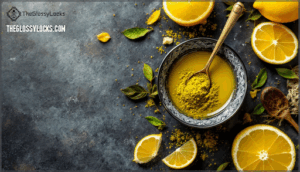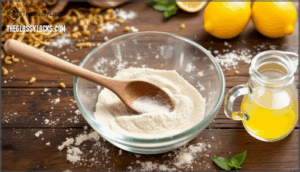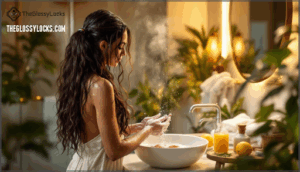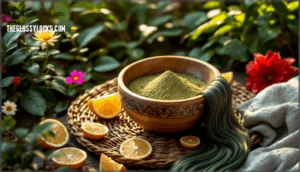This site is supported by our readers. We may earn a commission, at no cost to you, if you purchase through links.

The acidity in lemon juice breaks down henna’s plant compounds, releasing deeper pigments that bond to your hair’s keratin instead of sitting on the surface. You’re not just coloring your hair; you’re fortifying it with plant-based conditioning agents that commercial products can’t replicate.
This guide walks you through the exact ratios, timing, and techniques that transform raw henna powder and citrus into a professional-grade treatment customized for hair that’s never seen bleach.
Table Of Contents
- Key Takeaways
- Benefits of Mixing Henna With Lemon Juice
- Choosing The Right Henna and Lemon Juice
- Preparing The Henna and Lemon Juice Mixture
- Achieving Vibrant Color With Lemon Juice
- Step-by-Step Application Process
- Preventing Dryness and Scalp Irritation
- Alternatives to Lemon Juice for Sensitive Skin
- Maximizing Henna Color Longevity
- Common Mistakes and Troubleshooting Tips
- Frequently Asked Questions (FAQs)
- Conclusion
Key Takeaways
- Mixing henna with lemon juice releases deeper pigments through acidity (pH 2.3) that bond to your hair’s keratin while strengthening strands, unlike commercial dyes that strip your hair’s natural structure with harsh chemicals.
- The lemon-henna combination requires careful dilution (50/50 with water) to prevent scalp irritation and dryness, with processing times of 3-4 hours delivering optimal color intensity on unbleached hair.
- Your natural base color and hair porosity determine results—dark hair gains auburn depth while lighter shades develop visible copper tones, with color continuing to deepen over weeks through oxidation.
- Alternatives like apple juice or cranberry juice offer gentler pH levels (3.4-4.5) that still activate dye release without the aggressive acidity that can damage sensitive scalps or strip moisture from your hair.
Benefits of Mixing Henna With Lemon Juice
If you’re ready to break free from chemical dyes and take control of your hair color naturally, mixing henna with lemon juice might be your ticket to vibrant results. The acidity in lemon juice unlocks henna’s coloring potential, but it comes with trade-offs you’ll want to understand before you commit.
Let’s explore what makes this combination powerful—and what you should watch out for.
Natural Hair Coloring and Nourishment
Henna paired with lemon juice transforms hair from the inside out, delivering rich, natural color while strengthening every strand without the chemical baggage of conventional dyes. This powerhouse combo nourishes your scalp health while promoting hair growth, giving you the color depth you want without compromising your natural hair care routine.
The henna benefits extend beyond aesthetics—it conditions as it colors, making each henna application a treatment that works with your hair’s natural structure instead of against it.
Enhanced Dye Release and Color Intensity
When you add acidic liquid to your henna mix, you’re unlocking a whole new level of color potential. Lemon juice works overtime to boost lawsone availability and improve aglycone molecules, giving you that immediate vibrancy water alone can’t touch. Here’s what happens:
- Gradual release over 8–12 hours maximizes dye molecule extraction while controlling oxidation
- pH ~2.3 environment pulls more lawsone from henna powder than plain water
- Vivid, fiery orange tones appear instantly on unbleached hair, with stronger saturation
The acidic environment doesn’t just speed things up—it fundamentally changes how henna hair dye binds to your strands, creating richer initial color and deeper penetration.
Understanding the effects of acidic liquid mixes is essential for achieving the desired results with henna.
Chemical-free Hair Care Advantages
While you’re unlocking richer color through acidity, you’re also steering clear of ammonia, PPD, and synthetic additives that strip your scalp’s natural defenses. Organic henna hair dye paired with lemon juice gives you sustainable beauty without the chemical baggage—just pure hair nutrition that respects your body’s natural balance.
| Chemical Dyes | Henna + Lemon Juice | Your Hair’s Future |
|---|---|---|
| Ammonia burns | Gentle shampoos needed after | Healthier scalp long-term |
| PPD allergens | Natural hair care ritual | No synthetic buildup |
| Synthetic sealants | Organic products only | True hair nutrition |
| Scalp damage | Lemon juice acidity (manageable) | Sustainable beauty routine |
This natural beauty products approach puts you back in control of what touches your scalp.
Suitability for Unbleached Hair Types
Your natural hair color—especially if it’s virgin, unbleached, and rich in melanin—acts like a canvas that determines how henna and lemon juice will show up. Understanding your base shade before you mix can save you from unexpected results. Dark brunettes gain auburn depth, while lighter shades pick up more visible copper tones.
Hair porosity matters too—coarse hair texture absorbs the henna mix differently than fine strands, affecting color depth and natural shine. Your scalp health influences how lemon juice reacts, making this natural hair dye combo ideal for untreated hair care routines.
Choosing The Right Henna and Lemon Juice
Getting the right ingredients makes all the difference when you’re mixing henna with lemon juice. You’ll want to break free from chemical-laden products and choose materials that work with your hair, not against it.
Let’s look at what you need to know about selecting quality henna, choosing your lemon juice, and figuring out if this mix suits your specific hair type.
Selecting Pure, Organic Henna Powder
The quality of your henna powder can make or break your entire coloring experience, so knowing what to look for isn’t just helpful—it’s essential. Start by hunting down pure, organic henna powder with legitimate organic certification—this guarantees you’re getting natural ingredients free from synthetic additives that can sabotage your henna application.
Look for powder sourced through sustainable farming practices, which generally yields high-quality powder. The finest natural hair dye comes from freshly ground Lawsonia Inermis leaves, giving you that authentic henna mix without chemical interference.
Picking Fresh or Bottled Lemon Juice
Choosing between fresh-squeezed and bottled lemon juice might seem like a minor detail, but this decision directly impacts how your henna releases dye and how your scalp feels during the process. Fresh juice delivers maximum potency as an acidic liquid, though it requires juice extraction effort. Here’s what matters when picking your lemon juice types:
Here are the key considerations when choosing your lemon juice:
- Fresh lemon varieties offer stronger acidity for faster dye release in your henna mix
- Bottled options provide consistent pH levels, making your hair color results more predictable
- Freshness factors affect how intensely the acidic liquid triggers color development
- Bottled vs fresh comes down to convenience versus control over acidity strength
- Organic bottled juice works perfectly fine if fresh lemons aren’t available
Both options work for henna application—choose based on your access and sensitivity.
Identifying Hair Types Suited for This Mix
Not every head of hair responds the same way to henna and lemon juice—some textures thrive with this acidic combo, while others end up dry, brittle, or disappointed with the color payoff. Your hair texture and porosity levels determine how well your strands absorb the henna mix and tolerate lemon juice acidity.
Coarse, thick hair tolerates lemon juice’s drying effects better than fine strands during henna application.
| Hair Characteristic | Best Match | Watch Out |
|---|---|---|
| Porosity Levels | High porosity grabs color fast | Low porosity needs longer processing |
| Natural Tones | Dark brown to black shows rich depth | Light hair may darken unpredictably |
| Scalp Sensitivity | Resilient scalps tolerate acidity | Sensitive types risk irritation |
Preparing The Henna and Lemon Juice Mixture
Getting your henna mix right makes all the difference between vibrant color and a frustrating mess. The proportions matter, the mixing technique counts, and if you’ve got sensitive skin, you’ll want to know how to dial back that acidity without losing the dye release.
Here’s what you need to know to prepare your henna and lemon juice mixture properly.
Ingredient List and Proportions
Getting your proportions right is like nailing a recipe — too much of one thing throws off the whole batch, and with henna and lemon juice, that balance directly impacts your color payoff and scalp comfort.
Here’s your starter henna recipe for proportion control:
- 100 grams henna powder (adjust based on hair length and thickness)
- Lemon juice amount: 1/4 cup, diluted with equal parts water to prevent irritation
- Optional additions: 1-2 tablespoons sugar for better dye release and smoother henna mix
- Ingredient quality matters: Use fresh, organic henna powder and real lemon juice for ideal mixing techniques and color results
Step-by-step Mixing Instructions
Mix your henna paste like you’re making pancake batter — start slow, add liquid gradually, and aim for a consistency that’s thick but spreadable, not soupy or clumpy.
| Step | Action | Why It Matters |
|---|---|---|
| 1 | Add henna powder to a non-metal bowl | Metal can interfere with dye release |
| 2 | Pour diluted lemon juice slowly, stirring constantly | Controls paste consistency and acid levels |
| 3 | Mix for 3-5 minutes until smooth | Breaks up clumps for even color |
| 4 | Cover and let rest 6-12 hours at room temperature | Activates dye release for vivid results |
| 5 | Check henna ratio—add warm water if too thick | Guarantees spreadable texture for application |
Your henna paste should look like yogurt when ready—smooth, thick enough to cling to a spoon, but easy to spread through your hair without dripping everywhere.
Adjusting Acidity for Sensitive Scalps
If lemon juice leaves your scalp tingling or itchy, dialing back the acidity isn’t about sacrificing color—it’s about making henna work with your skin instead of against it. Dilute lemon juice with equal parts distilled water to raise the pH balance closer to 4.5, which still triggers dye release without cranking acidic levels too high.
For citrus sensitivity or low hair porosity, swap half the lemon juice for apple juice or skip citrus entirely—your henna application doesn’t need extreme acidity to deliver bold color without scalp irritation.
Achieving Vibrant Color With Lemon Juice
Lemon juice doesn’t just acidify your henna—it transforms how the dye molecules develop and behave on your hair. The way acidity interacts with henna determines whether you’ll end up with fiery copper tones or deeper, richer shades.
Here’s what actually happens when you mix these two ingredients and how the color evolves from the moment you apply it to weeks down the road.
How Acidity Affects Henna Color Release
Acidity transforms how lawsone molecules escape henna’s structure and latch onto your hair. When you mix henna with lemon juice, you’re triggering acidic dye release—the pH ideal range sits between 3.0 and 4.0, where dye binding peaks and color stability holds strong.
Mixing henna with lemon juice triggers acidic dye release at pH 3.0–4.0, where lawsone molecules bind most effectively for peak color stability
Here’s what happens during the oxidation process:
- The acid breaks down cellulose walls in henna powder, freeing lawsone precursors that convert to aglycone intermediates
- Lemon juice (pH 2.0–3.0) speeds up dye release compared to plain water, darkening your stain over 48 hours to several months
- Henna pH levels below 2.5 increase citrus sensitivity and irritation without boosting color intensity
- Mildly acidic environments slow oxidation, giving you controlled, maximum dye release during an eight to twelve hour window
- Acidified henna application seals the hair cuticle, locking in pigment for richer, longer-lasting henna hair care results
Understanding the henna oxidation process is vital for ideal results.
Expected Color Results on Unbleached Hair
Understanding color depth analysis starts with your natural base. Light unbleached hair—blonde or light brown—transforms into deep copper or auburn after henna-lemon application, while dark brown or black hair shows subtle red shimmers under light.
Hair porosity effects play a huge role: porous strands drink up pigment for richer results, fine hair reveals brighter tones, and coarse textures display gentle highlights.
Natural shade variations mean your outcome is uniquely yours—strand tests before full application let you preview vibrant tone achievement without surprises.
Oxidation and Color Darkening Over Time
That initial vibrancy you loved doesn’t stay put—henna deepens steadily as oxygen works its magic on the pigment molecules embedded in your hair shaft. Lemon juice accelerates this oxidation effect, turning bright copper into mahogany over weeks.
The darkening process continues with each wash as henna hair dye locks deeper into your hair pigmentation. Highly acidic mixes sacrifice color stability—that fiery dye release gives way to richer, sometimes muddy tones through continuous oxidation effects rather than color fading.
Step-by-Step Application Process
Now that you’ve got your henna-lemon mixture ready, it’s time to actually put it on your hair. The application process requires some prep work and careful technique to get even coverage and the color results you’re after.
Here’s what you need to do before, during, and after applying the paste.
Prepping Hair Before Application
Before you even think about slathering that henna-lemon paste onto your strands, you need to set the stage for color that actually sticks and saturates evenly. Proper scalp preparation and pre-treatment make all the difference:
- Hair detox: Wash with clarifying shampoo to strip buildup, oils, and styling products that block dye penetration.
- Skip conditioner: Natural oils and conditioners coat strands, reducing hair porosity and preventing henna absorption.
- Dry completely: Damp hair dilutes the paste and weakens color intensity during henna application.
Applying The Henna-lemon Paste Evenly
Once your hair is prepped, the real art begins: sectioning, applying, and working that paste into every strand without turning your bathroom into a crime scene.
Divide hair into four quadrants, then work in one-inch sections from roots to tips. Use an applicator bottle or gloved hands to massage henna paste thoroughly for even coverage and ideal dye distribution.
| Application Step | Henna Application Tips |
|---|---|
| Section hair | Clip into 4 quadrants, work small |
| Check paste consistency | Should spread like thick yogurt |
| Apply root-to-tip | Saturate completely for even color |
| Secure and wrap | Pile high, cover with plastic cap |
Recommended Processing and Wait Times
After you’ve wrapped your henna-covered head in plastic, the waiting game officially kicks off—and patience here is the difference between dull disappointment and rich, lasting color. The dye release time and color development depend on your henna recipe’s acidity and desired intensity.
Processing steps for ideal results:
- Minimum wait: 2 hours for subtle tones and lighter coverage
- Prime range: 3-4 hours for vivid, saturated color on unbleached hair
- Maximum: 6 hours for deepest penetration (lemon juice oxidation effects intensify here)
Your henna paste continues working during processing, so resist rinsing early—you’d shortcut the entire chemical reaction.
Preventing Dryness and Scalp Irritation
Lemon juice can turn your henna experience from liberating to uncomfortable if you’re not careful. The acidity that releases vibrant dye can also strip moisture from your hair and irritate your scalp, leaving you with an itchy, dry aftermath instead of the gorgeous color you wanted.
Here’s how to protect yourself from the most common pitfalls and keep your hair healthy while getting bold results.
Risks of Using Undiluted Lemon Juice
Undiluted lemon juice is harsh enough to strip your hair’s defenses and leave your scalp vulnerable. With a pH around 2.0, it lifts hair cuticles, increasing porosity and breakage risk. Direct application strips natural oils, causing dryness and frizz.
The citric acid damage doesn’t stop there—it can trigger burning, redness, or even phytophotodermatitis when exposed to sunlight. Up to 24% of users experience visible scalp irritation, while photosensitivity raises your risk of sunburn and skin discoloration.
Hair pH balance matters, and lemon juice throws it off completely.
Signs of Irritation and How to Address Them
Your scalp will tell you when something’s wrong—tingling, redness, or persistent itching are the body’s alarm bells you can’t ignore. If you notice skin irritation or an itchy scalp, rinse immediately with cool water to halt further dryness. Here’s how to get irritation relief:
- Flush the area with lukewarm water to remove henna paste
- Apply aloe vera gel for sensitive skin soothing
- Use a gentle, sulfate-free shampoo to cleanse without stripping oils
- Moisturize with coconut oil to restore skin and hair balance
Tips to Keep Hair Moisturized Post-application
Locking in moisture after henna isn’t optional—it’s the difference between smooth, healthy strands and a dry, frizzy mess. Your hair nourishment routine should include natural hair oils like coconut or argan applied within 24 hours.
Here’s your post-application care strategy:
| Hair Moisture Tips | Product Type | Frequency |
|---|---|---|
| Scalp soothers (aloe vera gel) | Natural treatment | Daily for 3 days |
| Hydrating masks (avocado, honey) | Deep conditioner | Weekly for 4 weeks |
| Natural hair oils (jojoba, sweet almond) | Leave-in serum | 2-3 times weekly |
Skip harsh shampoos for 48 hours—organic and natural hair care means letting the color set while maintaining a hair care and maintenance balance.
Alternatives to Lemon Juice for Sensitive Skin
If lemon juice leaves your scalp feeling raw or your hair bone-dry, you’re not stuck with it. There are gentler acidic options that still release henna’s color without the harsh side effects.
Let’s look at three practical alternatives that won’t torch your skin or turn your hair into straw.
Milder Acidic Options (apple, Cranberry Juice)
If lemon juice leaves your scalp feeling like sandpaper, acidic juice alternatives like apple or cranberry juice might be your ticket to freedom. Apple juice sits at a gentler pH of 3.4, reducing irritation risk while still coaxing out copper tones in your natural dye release.
Cranberry juice, though equally acidic at 2.3, contains quinic and malic acids that maintain bright red henna application and tips without the relentless darkening lemon causes. Both options create stickier pastes thanks to natural fructose, which helps with gentle hair care by sealing moisture during processing.
This pH balance importance matters—your scalp will thank you.
Using Fruit Acid Powders for Dye Release
Fruit acid powders cut through the messiness of juices while giving you precision control over pH levels and color outcomes. Ancient Sunrise Copperberry and Kristalovino deliver powdered dye release without the scalp-burning drama of lemon juice, letting you dial in acidic mixtures that hit pH 4.5 perfectly.
These natural alternatives boost color stability while your henna recipe stays gentle—no photo-sensitivity, no darkening oxidation nightmare. You’re in command of your henna application and tips now.
Diluting Lemon Juice for Gentler Effects
If you still love the tang of fresh lemon but need to save your scalp from the acid assault, cutting it with water transforms that pH 2.3 beast into something your skin can actually tolerate. Dilution ratios like 50/50 or even 75% water bring pH balance closer to the ideal range of 4.5, giving you effective dye release without the burn.
Run a sensitivity testing patch on your inner arm before going all-in—gradual dilution lets you find your perfect acidic mixture threshold.
Maximizing Henna Color Longevity
You’ve done the hard work of applying henna with lemon juice—now it’s time to lock in that color and make it last.
The way you care for your hair in the first few days after application can make or break your results. Here’s how to protect your fresh henna and keep that vibrant shade from fading too fast.
Post-application Care Tips
The real magic of henna happens after you rinse out the paste, when your commitment to aftercare determines whether your color stays vibrant or fades into mediocrity. Your hair needs strategic henna aftercare for at least 24 hours—that’s when color locking reaches its peak potential. Resist the urge to shampoo immediately, because water exposure disrupts the oxidation process that deepens your shade. Instead, focus on scalp soothing and hair moisturizing with natural oils to prevent skin and hair irritation.
- Massage eucalyptus or amla oil into your scalp for deeper color penetration and to calm any lingering sensitivity from the cosmetic ingredients
- Keep your hands out of dishwater if you’ve applied henna designs—stain removal happens fastest when you’re elbow-deep in suds
- Apply a thin layer of Vaseline over hennaed areas to shield your hair treatment from environmental damage and lock in moisture
- Dip treated sections in cold water briefly to close your hair cuticles and trap the hair coloration molecules inside
Avoiding Water and Harsh Shampoos
Water becomes your worst enemy in those critical first 48 hours—every rinse you steal from your henna threatens to wash away the oxidation process before your color fully matures.
That’s why gentle rinsing without shampoo protects your henna paste investment and prevents skin and hair irritation. Harsh cleansers strip moisture retention and compromise color preservation, leaving your hair coloration vulnerable.
Skip the suds entirely—your scalp protection and hair hydration depend on this discipline during the critical oxidation window.
Using Oils and Vaseline for Protection
Essential oils and Vaseline create an invisible shield that locks your henna color deep into your hair strands while defending against environmental assaults. Massage eucalyptus or amla oil into your scalp after henna application for deeper color penetration and scalp soothing benefits.
Vaseline protection seals moisture around hairlines and prevents dirt from compromising your hair health. These oil benefits transform your lemon juice henna treatment into a fortified color fortress.
Common Mistakes and Troubleshooting Tips
You’re already breaking free from chemical dyes, but a few common slip-ups can sabotage your henna results. Too much lemon juice, patchy color, or an itchy scalp can turn your natural hair journey into a frustrating mess.
Here’s how to spot these mistakes and fix them before they ruin your vibrant, chemical-free color.
Over-acidifying The Henna Paste
Dumping too much acid into your henna mix is like turning up the heat too high on a slow-cooked meal—you’ll end up with results that are way more intense and unpredictable than you bargained for.
When pH levels drop too low from excess lemon juice, your henna paste releases dye too aggressively, leading to darker colors that keep deepening through oxidation. You’ll also risk hair damage and scalp irritation that could’ve been avoided with proper acid balance.
Uneven Color Results on Unbleached Hair
Uneven color on unbleached hair happens because henna interacts unpredictably with your natural base shade, creating patchy results that range from bright copper to muddy brown depending on how your individual hair strands absorb the dye. Hair porosity plays a huge role here—damaged sections grab more dye than healthy areas, causing tonal imbalance and shade inconsistencies across your head.
If you’re fighting color variation, apply your henna paste more generously to resistant spots and section your hair carefully to guarantee consistent dye penetration throughout.
Managing Itchiness and Dryness After Use
About 90% of people who complain about itchy scalps after henna used lemon juice as their acidic agent, and that low pH can turn your post-application experience into a scratchy nightmare if you don’t address it quickly.
Combat the discomfort with these post-application remedies:
- Rinse with cool water to close your pores and calm irritated skin without stripping protective oils.
- Apply coconut or jojoba oil for immediate hair moisturizing and dry scalp treatment.
- Use fragrance-free aloe vera gel on sensitive areas for itch relief methods that won’t aggravate skin sensitivity.
- Skip harsh hair care products for 48 hours to let your scalp recover from the acidic henna for hair treatment.
Frequently Asked Questions (FAQs)
Are there any safer alternatives to lemon juice for henna mixtures?
Apple juice, cranberry juice, and distilled water offer gentler Cosmetic Ingredients and Safety for your Natural Dye ritual.
Fruit Acid Options like Copperberry powder achieve pH Balance without the harsh bite, while these Gentle Mixers release henna for hair color beautifully without irritation in your henna paste recipe.
Can henna with lemon juice lighten dark hair?
Henna for hair doesn’t lighten dark hair tones—it deposits color instead of lifting it. When you mix henna paste with lemon juice, the lemon acidity intensifies henna dye release and color depth, but henna oxidation only adds reddish-brown pigment over your existing shade, never removing natural melanin.
How long should henna-lemon paste sit before applying?
Let your henna paste sit for 8 to 12 hours after mixing with lemon juice to boost dye release and color intensity.
This waiting period allows the acidic lemon juice to break down the henna’s plant material, releasing more lawsone for richer, longer-lasting results.
Does lemon juice affect hennas conditioning properties?
Yes, lemon juice can compromise henna’s conditioning benefits. Its high acidity (pH 3) can dry out your hair and irritate your scalp, especially during long processing times, reducing the natural moisturizing effects henna usually provides.
Will lemon juice cause henna to fade faster?
No, lemon juice won’t make henna fade faster. Actually, the oxidation effects from lemon acidity can deepen color stability over time.
Studies confirm henna products maintain excellent henna longevity—minimal fading even after 31 washes.
Conclusion
Skeptics claim that mix henna with lemon juice for unbleached hair delivers inconsistent results, but thousands of DIY colorists prove otherwise when they master the acid-to-powder ratio. You’ve now got the blueprint to break free from chemical formulas that promise vibrancy but deliver damage.
Your unbleached strands can absorb henna’s earthy reds and auburns without surrendering their integrity—lemon juice simply unlocks what commercial kits can’t replicate. Test your mixture on a hidden section first, then own your color transformation with plant-based confidence that strengthens with every application.
- https://ancientsunrise.blog/2018/05/15/lemon-juice-henna-mix/
- https://renaissancehenna.com/henna-plant-natural-hair-dye/how-henna-your-hair/
- https://www.henna-und-mehr.de/pdf/hennalemonqxt.pdf
- https://www.longdom.org/open-access/evaluation-of-herbal-henna-based-hair-colour-retention-study-through-chromo-meter-81613.html
- https://www.reddit.com/r/henna/comments/1emcaoa/lemon_on_henna_hair_with_sun_exposure_what_are/













